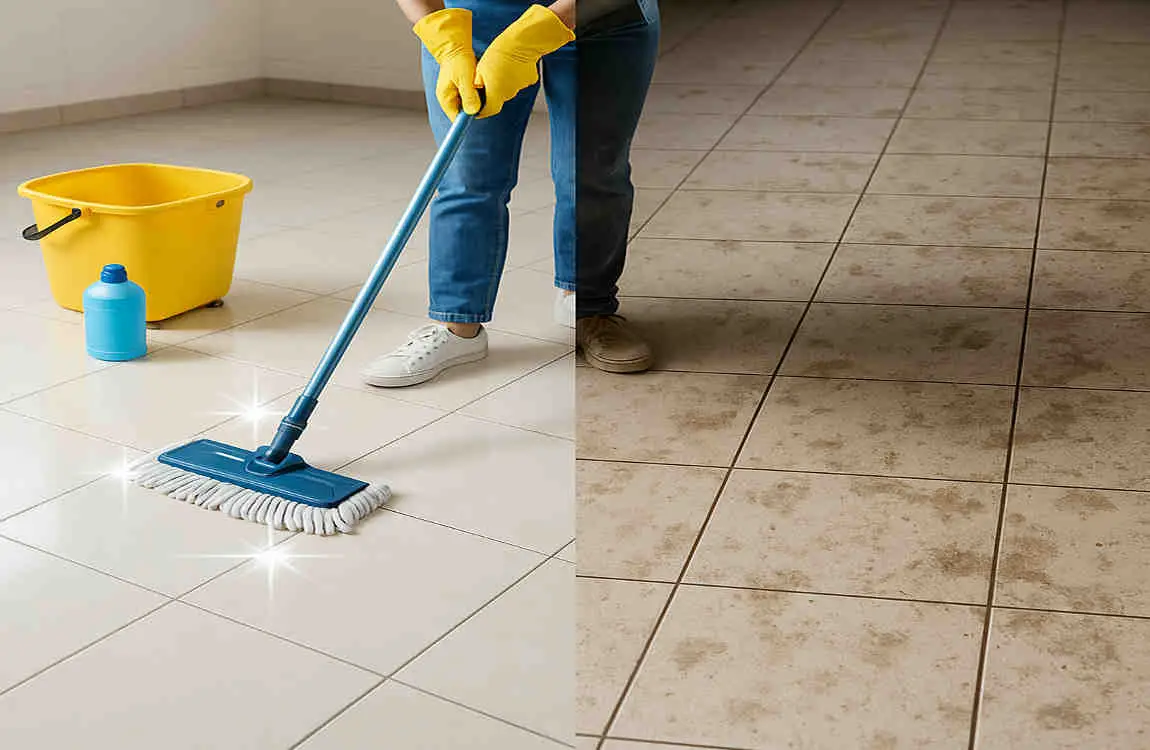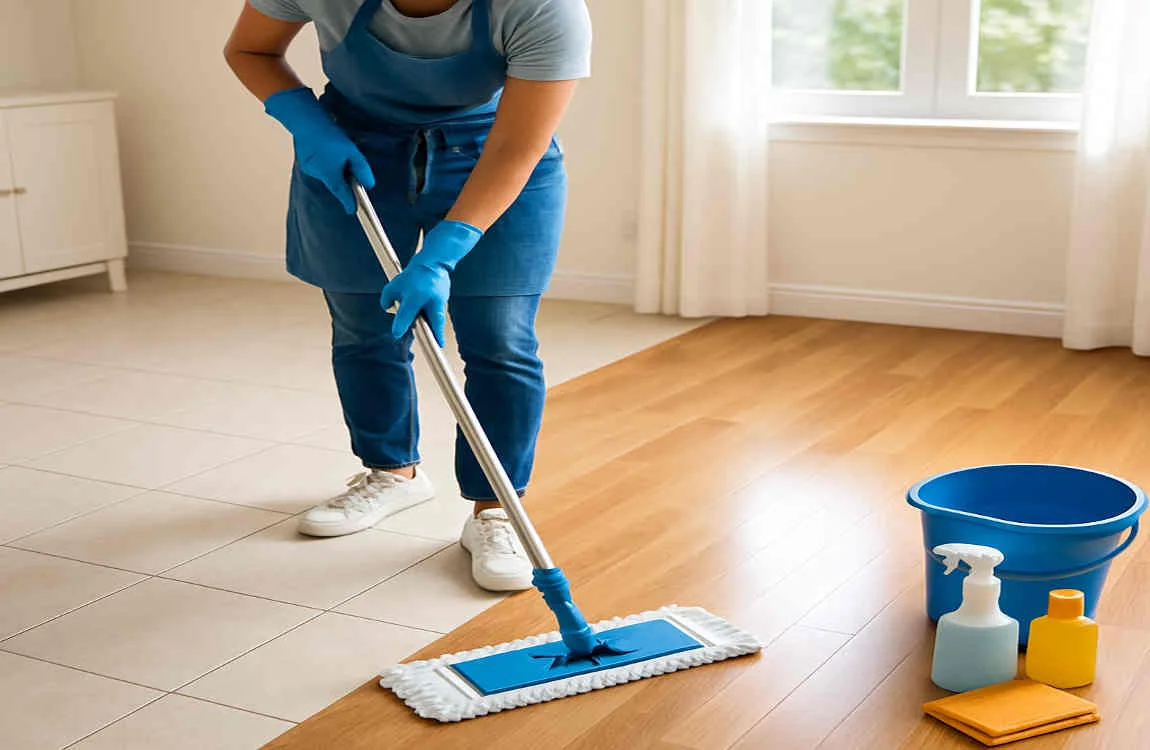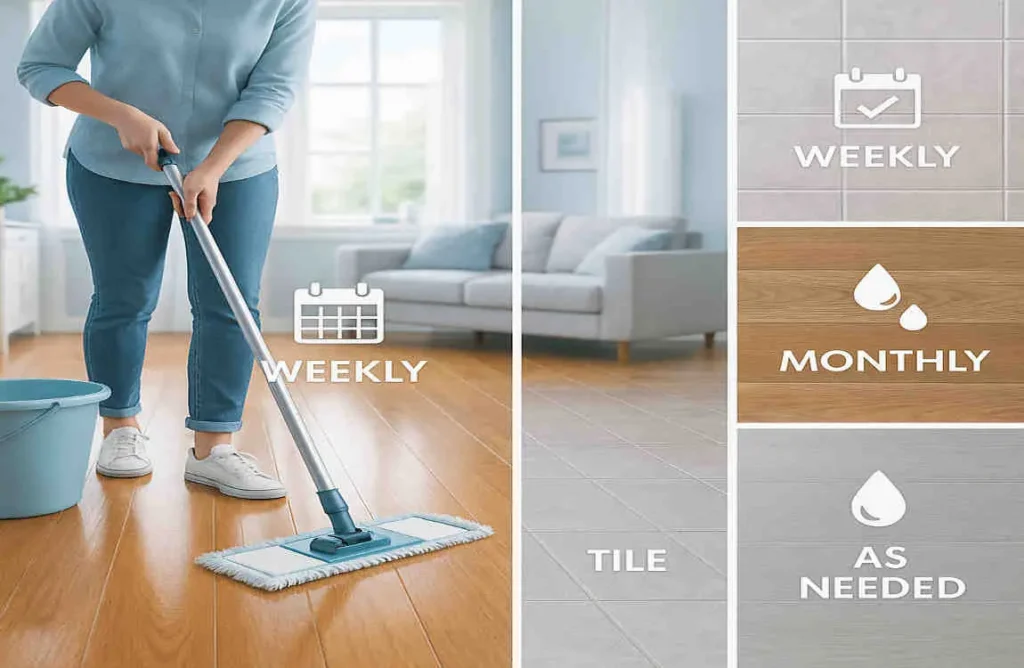Hey there, homeowner! Let’s talk about something that might not sound glamorous but is super essential for keeping your space feeling fresh and healthy: mopping your floors. You know, those surfaces we walk on every day, tracking in dirt, spilling drinks, and letting our pets leave their mark. A clean floor isn’t just about looks—it’s a big player in your overall home hygiene. Imagine breathing easier, reducing allergies, and even preventing slips from grimy buildup. But here’s the million-dollar question that pops up in so many cleaning forums and chats: how often should you mop your floors? It’s a standard puzzle, and misconceptions abound—like thinking vacuuming alone does the trick or that mopping too often damages your floors.
Many folks underestimate how dirt sneaks into our homes cleaning. From outdoor dust to kitchen spills, it all accumulates faster than you might think. I’ve heard people say they mop once a month and wonder why their floors still feel sticky. Others overdo it, leading to warped hardwood or faded tiles. The truth? There’s no one-size-fits-all answer. It depends on your lifestyle, floor type, and your location. That’s why we’re diving deep into this topic today.
Why Regular Mopping is Essential

The Role of Mopping in Hygiene and Preventing Dirt Buildup
Picture this: You sweep or vacuum your floors regularly, but somehow, they still don’t feel spotless. That’s where mopping steps in as the hero. Regular mopping isn’t just about shine—it’s your frontline defense against germs and grime. Dirt, bacteria, and even tiny pests like dust mites love to hide in the nooks and crannies of your floors. When you mop, you’re not only lifting away visible messes but also tackling those invisible threats that can make your family sick.
Think about high-traffic areas like your kitchen or entryway. Spills from cooking or mud from shoes create a breeding ground for bacteria. If left unchecked, this buildup can lead to stubborn stains that are harder to remove later. By mopping consistently, you prevent that accumulation, keeping your home safer and more hygienic. It’s like giving your floors a fresh start, which also reduces the risk of slips and falls. Have you noticed how a good mop session makes your whole room feel brighter?
How Mopping Impacts Indoor Air Quality and Allergen Control
Now, let’s connect the dots to something bigger: the air you breathe. Floors collect dust, pollen, pet dander, and other allergens that get kicked up every time you walk across them. Without regular mopping, these particles float into the air, aggravating allergies or asthma. A thorough mop with the right solution traps and removes these irritants, improving your indoor air quality.
For families with kids or anyone sensitive to allergens, this is a game-changer. Studies show that clean floors can cut down on airborne dust by up to 50%. It’s not just about sweeping it away—mopping wet and capturing it, so it doesn’t resettle. If you’re dealing with seasonal allergies, ramping up your mopping schedule could be your secret weapon. Doesn’t it feel great knowing a simple task like this boosts your health?
The Difference Between Sweeping, Vacuuming, and Mopping
Sweeping and vacuuming are great for loose debris, but they often leave behind a fine layer of residue. Sweeping pushes dirt around, while vacuuming sucks up the big stuff but misses sticky spots or ground-in grime. Mopping, on the other hand, uses water and cleaners to dissolve and lift that deeper dirt. It’s the finishing touch that makes your floors truly spotless.
For example, in a carpeted room, vacuuming reigns supreme. But on hard surfaces? Mopping seals the deal. Combining all three gives the best results—sweep or vacuum first to remove loose particles, then mop for that deep clean. This teamwork approach ultimately saves time and effort.
Benefits of Different Flooring Types
Different floors have unique needs, and mopping caters to them all. On hardwood floors, it restores natural luster without excessive moisture. Tile floors benefit from grout cleaning that prevents mold. Laminate stays protected from warping, while vinyl resists scuffs with gentle mopping. Even natural stones like marble can achieve a polished look. Regardless of your floor type, regular mopping extends its life and keeps it looking new. Ready to tailor this to your home?
Factors Influencing How Often You Should Mop Your Floors
Household Size and Foot Traffic Levels
Let’s get personal—how many people live in your home? A bustling family of five will track in way more dirt than a solo dweller. High foot traffic means more mud, crumbs, and spills, so you’ll need to mop more often to keep up. Think about your daily routine: Do guests come over frequently? If yes, those extra footsteps add up quickly.
You may also read (discover the art of hardwood home floor refinishing).
For a small household, mopping every week or two might suffice. But in a larger home with constant activity, aim for twice a week. It’s all about balance—don’t let dirt win, but avoid over-mopping that could wear down your floors. What’s your household like? Adjusting based on this factor can make a significant difference in your floor cleaning frequency.
Presence of Kids and Pets
Kids and pets are adorable, but they’re also dirt magnets! Little ones spill juice, drop snacks, and play on the floor, while pets bring in fur, dander, and outdoor muck. If you have toddlers crawling or dogs zooming around, expect more frequent mopping to handle the messes.
Pets with long fur might require daily spot-cleaning in high-traffic zones. For families with young children, focus on kitchens and play areas where sticky residues form fast. This not only keeps things clean but also safer for everyone. Remember, a pet-friendly home means adapting your mopping schedule to their habits—it’s worth it for those wagging tails!
Flooring Material Sensitivity and Manufacturer Recommendations
Not all floors are created equal. Some materials, like delicate hardwood, can warp if mopped too often with too much water. Check your manufacturer’s guidelines—they usually specify ideal floor care tips and frequencies. For instance, sealed hardwood may require weekly mopping, but unsealed versions need less moisture.
Tile and vinyl are more forgiving, but grout on tiles can harbor bacteria if not mopped regularly. Laminate resists water but scratches easily, so gentle methods are key. Always follow those recs to avoid voiding warranties or causing damage. Have you read your floor’s care manual lately?
Environmental Factors: Climate, Dust, Pollen Seasons
Where you live plays a significant role, too. In dusty, dry climates, floors collect more particles, demanding more frequent mopping. Humid areas might see mold risks, so mopping helps control moisture. During pollen season, allergens pile up faster—especially if windows are open.
Rainy weather tracks in mud, while winter salt from boots can etch floors. Adjust your routine seasonally: more in spring for pollen, less in low-activity winters. It’s smart to stay ahead of these environmental curveballs for a consistently clean home.
Lifestyle Habits (Cooking Style, Shoe Policies Indoors)
Your daily habits shape your mopping needs. Love cooking elaborate meals? Kitchen floors will get greasy faster from splatters. A no-shoes policy indoors cuts down on tracked-in dirt dramatically—try it if you haven’t!
If you entertain often or have hobbies like crafting, expect localized messes. Simple changes, such as using mats at entrances, can reduce overall grime. Tailor your How frequently should you mop your floors question to these habits for the best results. What minor tweak could you make today?
Recommended Mopping Frequencies for Different Floor Types
Hardwood Floors: Optimal Mopping Frequency and Care Tips
Hardwood floors bring warmth and elegance to any home, but they require careful handling. How often should you mop your floors if they’re hardwood? Generally, once every 1-2 weeks works well for low-traffic homes. In busier spots, bump it to weekly to prevent dirt from scratching the finish.
Use a damp—not soaking—mop with a wood-specific cleaner to avoid warping. Always wring out excess water and dry immediately. For sealed hardwood, a mix of vinegar and water is gentle. Avoid steam mops, as heat can damage the wood. Regular care like this keeps your floors looking their best for years. Have you tried a microfiber mop? It’s a game-changer for even cleaning.
Tile Floors: Best Practices and Frequency for Maintaining Grout
Tile floors are durable and easy to clean, making them ideal for kitchens and bathrooms. Aim to mop them every 3-7 days, depending on use. High-traffic tiles may require twice-weekly attention to prevent grout lines from discoloring.
Focus on grout—it’s porous and traps dirt. Use a baking soda paste for deep cleans, followed by a neutral pH cleaner. Scrub gently with a soft brush. For glossy tiles, avoid abrasive tools to prevent scratches. This routine prevents mold and keeps your tiles looking fresh. Pro tip: Seal grout annually for easier maintenance.
Laminate Floors: Dos and Don’ts When Mopping
Laminate mimics wood or stone but at a lower cost, and it’s sensitive to moisture. Mop every 1-2 weeks, using minimal water to avoid swelling edges. Opt for a spray mop system for control.
Do: Use laminate-safe cleaners and dry floors right after. Don’t: Let water pool or use oil-based products that leave residue. Vacuum first to remove debris that could scratch. With these floor care tips, your laminate stays pristine without the hassle.
Vinyl Floors: How Often and Which Cleaning Solutions to Use
Vinyl is rugged and affordable, handling spills like a champ. For most homes, mopping every 4-7 days suffices, but kitchens might need more due to grease.
Choose mild soap or vinyl-specific solutions—avoid harsh chemicals that dull the surface. A mixture of warm water and dish soap works wonders. Mop in sections, rinsing as you go. This keeps vinyl resistant to scuffs and easy to maintain.
Natural Stone Floors: Special Considerations for Mopping Frequency
Natural stone, such as marble or slate, adds luxury, but it’s porous and requires gentle care. Mop every 1-2 weeks, using pH-neutral cleaners to prevent etching from acids.
Seal stone floors periodically to repel stains. Avoid vinegar or lemon-based solutions—they can damage the surface. For travertine, focus on drying to prevent water spots. These steps preserve the stone’s natural beauty.
Here’s a quick reference table for mopping frequencies:
Floor Type Recommended Frequency Key Care Tip
Hardwood 1-2 weeks. Use a damp mop, dry immediately
Tile 3-7 days Scrub grout lines regularly
Laminate 1-2 weeks, Minimal water, no pooling
Vinyl 4-7 days, Mild soap solutions
Natural Stone 1-2 weeks , pH-neutral cleaners only
Adjust your approach based on your home’s specific needs for the most effective way to mop floors.
Signs You Need to Mop Your Floors
Visual Cues: Dirt, Stains, Sticky Spots
Sometimes, your eyes tell the story. Look for visible dirt buildup, like dust bunnies in corners or dark streaks from shoes. Stains from spills that have set in are a clear signal—don’t let them become permanent.
Sticky spots, especially in kitchens, indicate residue from food or drinks. If your floors look dull instead of shiny, it’s time. Walk around barefoot; if you see footprints or smudges, grab that mop. These cues help you act before things get worse.
Smell and Odor Indicators
Your nose knows! A musty or sour smell wafting from the floors often means trapped dirt or bacteria. Pet owners might notice lingering animal odors that vacuuming misses.
In humid areas, moldy scents signal moisture issues. If the room doesn’t smell fresh after airing out, mopping with a scented cleaner can refresh it. Pay attention—odors are a sneaky sign your floor cleaning frequency needs a boost.
Feeling of Stickiness or Residue Underfoot
Step on your floor without shoes. Does it feel tacky or gritty? That’s residue from daily life building up. It’s uncomfortable and attracts more dirt.
This stickiness often comes from improper previous cleanings or spills. If it persists, it’s a strong hint to mop sooner. Addressing it keeps your home feeling inviting.
When Last Cleaned vs Current Floor Condition
Track your last mopping session. If it’s been over your usual interval and floors feel off, don’t wait. Compare: Clean floors are smooth and odor-free; neglected ones show all the signs above.
Building this awareness helps refine your mopping schedule. How long has it been for you?
Expert Tips on Mopping for a Cleaner Home

Best Mopping Tools and Products for Different Floors
Choosing the right tools makes mopping easier. For hardwood, go with a flat microfiber mop—it’s gentle and effective. Tile lovers, try a spin mop for effortlessly wringing out water.
Products matter too. Use wood-safe cleaners for hardwood, and grout-specific ones for tiles.
How to Mop Effectively to Avoid Damage
Start by sweeping or vacuuming to remove loose dirt. Then, mix your solution and mop in small sections, working from back to front.
Use the active voice here: Dip, wring, mop, rinse—repeat. Dry floors quickly with a towel to prevent streaks. This method avoids damage and ensures a streak-free shine.
Eco-Friendly and Homemade Cleaning Solutions for Mopping
Go green! A simple vinegar-water mix (in a 1:10 ratio) cleans most floors naturally. Add essential oils for scent.
For tougher spots, mix baking soda and water to form a paste. These homemade options are cheap, safe, and effective. Why not try one next time?
Mistakes to Avoid While Mopping
Don’t use too much water—it can warp floors. Avoid mixing cleaners that create fumes. Never mop without pre-cleaning; it just spreads dirt.
Skipping drying leads to slips and spots. Learn from these to master the best way to mop floors.
How to Maintain Floors Between Moppings
Between sessions, spot-clean spills immediately. Use doormats to trap dirt at doors—vacuum weekly to reduce buildup.
Here’s a quick list of maintenance tips:
- Place rugs in high-traffic areas.
- Enforce a no-shoes rule.
- Wipe up spills right away.
- Use furniture pads to prevent scratches.
How to Create an Effective Floor Cleaning Schedule
Tips for Designing a Mopping Schedule Based on Your Lifestyle
Start by assessing your needs—busy home? Weekly mops. Quiet space? Bi-weekly.
Factor in factors from earlier sections. Make it flexible: More in messy seasons, less otherwise. Personalize it to fit your routine.
Combining Sweeping/Vacuuming with Mopping for Optimal Results
Team them up! Sweep or vacuum daily in key areas, then mop to finish.
This combo tackles all dirt levels. For example, vacuum Mondays, mop Wednesdays—simple!
Using Reminders and Apps to Stay Consistent
Set phone reminders or use apps like Todoist for cleaning alerts.
Track progress in a journal. It keeps you accountable and motivated.
Adjusting Frequency Seasonally and for Special Circumstances
Ramp up in pollen season or after parties. Dial back during vacations.
For events like holidays, add extra sessions. Adapt as life changes—it’s key to success.
You may also read (how to clean safety flooring at home easy house cleaning tips).
